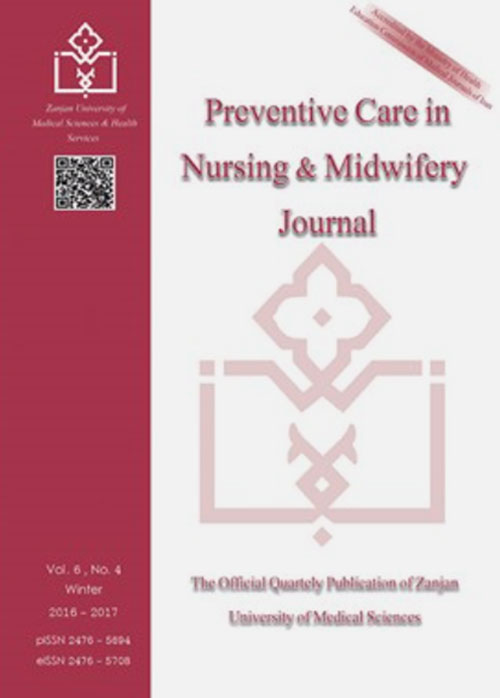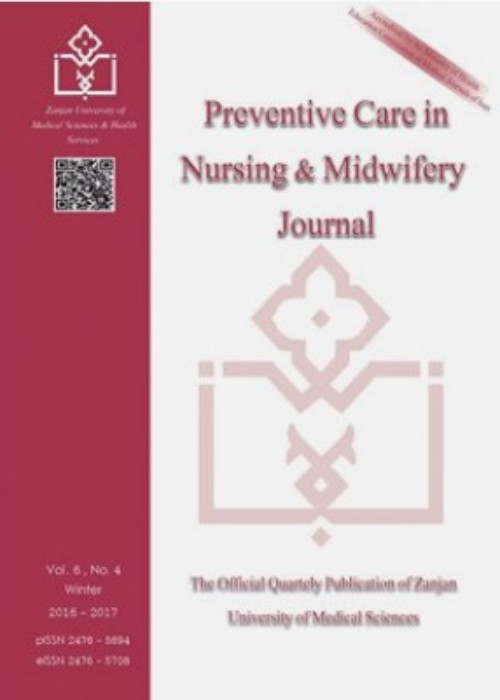فهرست مطالب

Preventive Care in Nursing & Midwifery Journal
Volume:7 Issue: 1, spring 2017
- تاریخ انتشار: 1396/03/31
- تعداد عناوین: 8
-
-
Pages 1-7BackgroundDelirium is a common problem in patients hospitalized in Intensive Care Unit. Despite the importance, only less than 13% of cases are diagnosed by physicians and medical personnel.ObjectivesThe present research aimed to study knowledge and attitude of critical care nurses towards delirium.MethodsThis cross-sectional study was conducted in Iran. Convenience sampling was used to enroll nurses (186 persons) working in intensive care units of Rasht educational hospitals affiliated to Guilan University of Medical Sciences in 2015. Data collection instruments included a three part questionnaire: demographic data, 15- item questionnaire formerly used by Guthrie and Sendelbach (2009) on nurses knowledge about delirium, and 10-item questionnaire adopted from Herrero et al on attitude of the nurses towards delirium. The obtained data were statistically analyzed using descriptive statistics, Pearson's correlation coefficient and t- test in SPSS-20.ResultsThe majority of nurses (68.3%) have intermediate knowledge about delirium and only 24.6 percent reported good knowledge and 76 percent had positive attitude about delirium.ConclusionNursing knowledge and awareness have a significant role in improvement of the quality of healthcare and preventive measures, as well as the attitude of nurses towards dealing with delirium patients. Hence, it is recommended to give greater importance to academic courses and ongoing post-graduation professional development programs in the workplace, as a globally practiced healthcare quality improvement strategy.Keywords: Delirium, Knowledge, Attitude, Nurses, Intensive Care Units
-
Pages 8-17BackgroundWork-family conflict is one of the components which have been paid attention in the present era due to changes and evolutions taken place in the field of work nature.ObjectivesThe present research was conducted by the aim of investigating the effect of relationship enhancement on solving work-family conflict.MethodsThis is a quasi-experimental study with pretest post-test design with a control group. 30 married staff working in municipality of Karaj city were selected by simple random sampling method, and were allocated randomly into intervention and control groups (n=15). Data was gathered through Rastegar khaled 17 item family-work conflict questionnaires. For the intervention group, relationship enhancement program was held through 7 educational sessions per week. Control group did not receive any formal educational training until the end of the research process. The research data were analyzed through univariate analysis of covariance (ANCOVA) in SPSS 20.ResultsThe results indicated that there is a significant difference between intervention and control groups in the family-work conflict variable. In other words, relationship Enhancement program has led to solving family-work conflict among the intervention group subjects in the posttest stage.ConclusionIt is suggested that counselors use this educational program in different occupational organizations and institutions for the purpose of reducing work family conflicts and improving relationships.Keywords: Relationship Enhancement, Family-Work Conflict
-
Pages 18-26BackgroundAsthma is considered as the most common chronic disease of childhood that can cause missing school and daily limits. It can also have effects on physical, psychological, and social well being in children. Therefore, improving two indicators of self-efficacy and self-esteem seem of utmost importance in this domain.ObjectivesThe purpose of this study was to determine the effect of family centered empowerment model (FCEM) on self-efficacy and self-esteem in children with asthma.MethodsIn this quasi-experimental study, 60 children along with their parents were randomly divided into two experimental and control groups. Then, family-centered empowerment model was implemented for the experimental group lasting seven 30-minute sessions. After that, self-efficacy and self esteem were similarly evaluated by distributing questionnaires in both groups before and after the intervention. Moreover, the data were analyzed using the SPSS Software as well as descriptive statistics (frequency, mean, and standard deviation) and inferential statistics (Chi-square test, Fishers exact test, independent t test, and paired t-test).ResultsThe self-efficacy scores of all children in the experimental group before (2.95±0.33) and after (3.97±0.49) the intervention showed a significant difference (P=0.0001). Meanwhile, a significant difference was observed in the self-esteem scores of all children in the experimental group before 0.62±0.13) and after (0.77±0.08) the intervention (P=0.0001), while self-efficacy scores of the individuals in the control group before (2.86±0.49) and after (2.88±0.40) the intervention suggested no significant difference (P=0.607) in this respect. Furthermore, there was no significant difference in self-efficacy scores of the control group before (0.67±0.17) and after (0.67±0.13) the intervention (P=0.845).ConclusionIt seems that empowerment (FCEM) of children suffering from asthma can lead to increased self-efficacy and self-esteem and help them to have an efficient care, and also may result in improvements in their roles. Therefore, further studies are recommended in this domain.Keywords: Asthma, Self-efficacy, Self-esteem, family-centered empowerment model (FCEM)
-
Pages 27-36BackgroundBreast cancer is the most common cancer that endangers the women's mental health.ObjectivesThe purpose of this study is to evaluate the effectiveness of stress management consulting on coping strategies in women with breast cancer.MethodsThis is a quasi-experimental, with pre- and post-test design and follows up with control and intervention groups. 104 women with breast cancer referring to MRI Center of Mahdieh in Hamadan-Iran in 2015 were divided randomly into two groups that the number of each group using permutation blocks was 52. The intervention group received the stress management counseling sessions through. Data collection tools were demographic questionnaire and general health questionnaire and the questionnaire of coping strategies of Lazarus & Folkman. For data analysis, the descriptive statistics and repeated measures analysis were used.ResultsThe results of this study showed that the intervention can improve the general health and its sub-scales in intervention group. After intervention, a significant difference in average scores of the general health in two groups was observed (PConclusionThe cognitive-behavioral group therapy of stress management can improve general health and increase coping strategies in patients with breast cancer, so this method can be used in oncology centers as the complementary therapy alongside the medical treatments.Keywords: cognitive-behavioral therapy group, stress management, general health, Coping strategies, breast cancer
-
Pages 37-44BackgroundGastroesophageal reflux disease (GERD) is one of the most common digestive system disorders. Life style factors may increase the risk of reflux disease.ObjectivesWe aimed to estimate prevalence of reflux and related life style factors among the population live in Qom.MethodsThis is a cross-sectional study conducted among 1500 residents of Qom-Iran in 2014. Individuals were selected through a multi-stage sampling. They completed two questionnaires: FSSG questionnaire for diagnosis of GERD and a general questionnaire to measure demographic and lifestyle factors.ResultsAfter data manipulation, 1130 individuals were analyzed in which 52/4% of them were female. Prevalence of GERD was 28%. The adjusted findings showed using PPIs (OR: 2.2, 95% CI: 25), taking H2RAs (OR: 4.7, 95% CI: 2.39. 4), the habit of quick eating (OR: 1.5, 95% CI: 1.12), extra salt consumption on daily meals (OR: 1.5, 95% CI: 1.052), lack of sleeping (OR: 2.6, 95% CI: 1.54.8), and consumption of white bread (OR: 1.7, 95% CI: 1.052.7) were related to increase the risk of GERD.ConclusionOur findings showed lifestyle factors such as the habit of quick eating, extra salt on regular meals, lack of sleeping and using white bread were associated with increased risk of GERD. However, the habit of midnight snack, having dinner just before bedtime, lack of breakfast, smoking, drinking tea and coffee were not associated with increasing risk of GERD. It is recommended to carry out a cohort study among Iranians to evaluate the effect of life style risk factors on GERD.Keywords: Gastroesophageal reflux disease, FSSG (Frequency Scale for the Symptoms of GERD), Lifestyle, Risk factor, Cross-sectional
-
Pages 44-51BackgroundThe premenstrual Syndrome is a collection of physical, mental and emotional symptoms which influence the quality of individuals life, so it is important to control and treat it.ObjectivesThe aim of this study was to investigate the effect of Training Premenstrual Coping Skills in Undergraduate Students in the School of Nursing and Midwifery, Hamadan-Iran.MethodsThis is a quasi-experimental study including a before and after design on 140 students of Nursing and Midwifery in Hamadan-Iran, which was conducted in 2015. 80 Eligible individuals were selected by convenience sampling method and randomly assigned to intervention and control groups. The research tool which we used was a questionnaire related to stress and coping strategies before and it was completed before and two months after the intervention in two groups. The students were trained the coping skills in the intervention group over five weeks, for 60 to 90 minutes.ResultsThe average age between girls in intervention group is 21.71±3.21 and control group 21.94±3.16 is years old. Based on the results of Wilcoxon test average tension scores comparison before Menstruation and also before and after intervention in each different statistical group is meaningful (pConclusionTraining the Coping skills had no significant impact on reducing premenstrual stress, but contributes to improving people's coping skills. It is recommended to hold premenstrual stress coping skills training sessions with a longer time to achieve valuable results.Keywords: coping strategies, stress, pre-menstrual syndrome, training
-
Pages 52-57BackgroundIntraventricular hemorrhage (IVH) is one of the most important causes of cognitive and motor disorder in children with very low birth weight and is associated with high mortality and disability rate.ObjectivesThe aim of this study was to determine IVH risk factors in the first days of life in neonates weighing less than 1500g (VLBW) so that the results can contribute to the improvement of the therapeutic function of the delivery room and ultimately IVH risk prevention.MethodsThis descriptive study was conducted on 110 VLBW neonates who were admitted to the hospital affiliated to Zanjan University of Medical Sciences during the years 2012-2013 Zanjan-Iran. Parameters including gender, birth weight, birth Apgar, regimens, and type of delivery were recorded in the questionnaire and data analysis was conducted using Chi-square test in SPSS.ResultsFrom 110 studied neonates, 21(19%) had IVH, of which 11(52%), 5(23.8%) and 5(23.8%) suffered from Grade I, II and III IVH, respectively. Meanwhile, among the studied variables, recovery steps were taken in the delivery room in the IVH group. The cranial ultrasonography was carried out for these neonates in the first 72 h of birth and they were categorized as Grade one to four, based on evidence of brain hemorrhage. There was a significant difference between maternity and infant information and without IVH; but it was not statistically significant.ConclusionAccording to the present study, the recovery process seemed to be a risk factor for the incidence of IVH in neonates; therefore, the health level of neonates can be improved by optimizing the mentioned process and reducing this risk factor.Keywords: Intraventricular hemorrhage, very low birth weight, recovery steps, APGAR, Znjan, Iran
-
Pages 58-66BackgroundPregnant women need information, skills and social support for the effectiveness of pregnancy care. Health education patterns play a major role in educational needs assessment in designing and implementing educational interventions.ObjectivesThe present study aimed to investigate the pregnancy care behaviors, based on the health belief and social support model among pregnant women.MethodsThis cross-sectional study was conducted in 2016 with the participation of 215 pregnant women under the control of faculty of Iranshahr Medical Sciences who were selected by multi-stage sampling method. The data were collected through a questionnaire based on the structures of the health belief and social support model, knowledge, behavior and demographic information. Data were analyzed by descriptive, Pearson correlation and multivariate regression tests in SPSS ver19 software.ResultsThe highest rate of education among pregnant women (35.8%) was high school. The mean score of mother's performance was 12.31 out of 22, and among the structures the perceived sensitivity score was the strongest, and the social support score was the weakest. Based on regression analysis, self-efficacy, perceived benefits, and social support were predictive behaviors which generally predict 27.5% of behavioral changes.ConclusionBased on the results, the structures of self-efficacy, perceived benefits and social support should be considered as the most important predictor of pregnancy care behaviors in designing educational interventions.Keywords: pregnancy care, pregnancy, health education, Iranshahr, Iran


